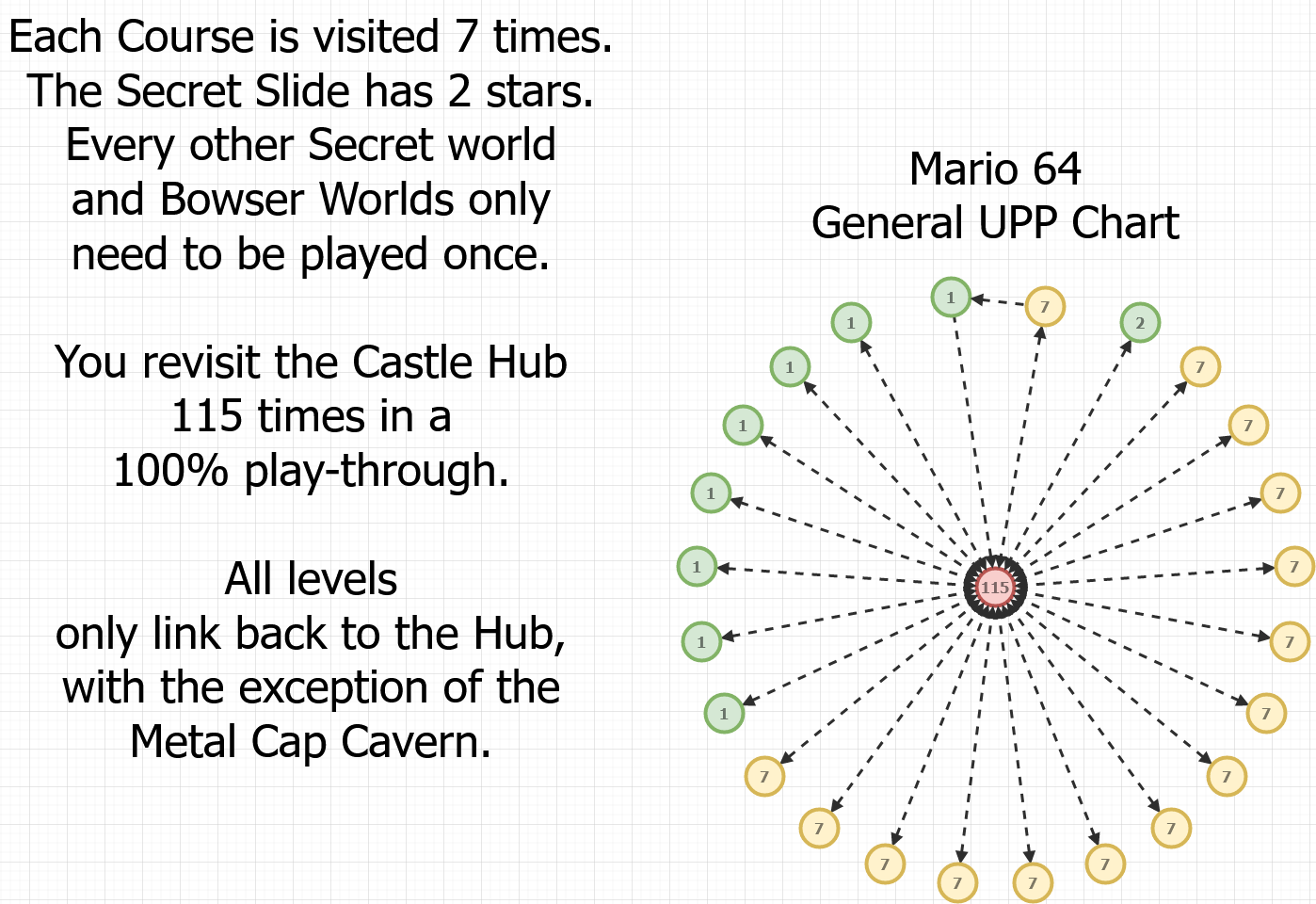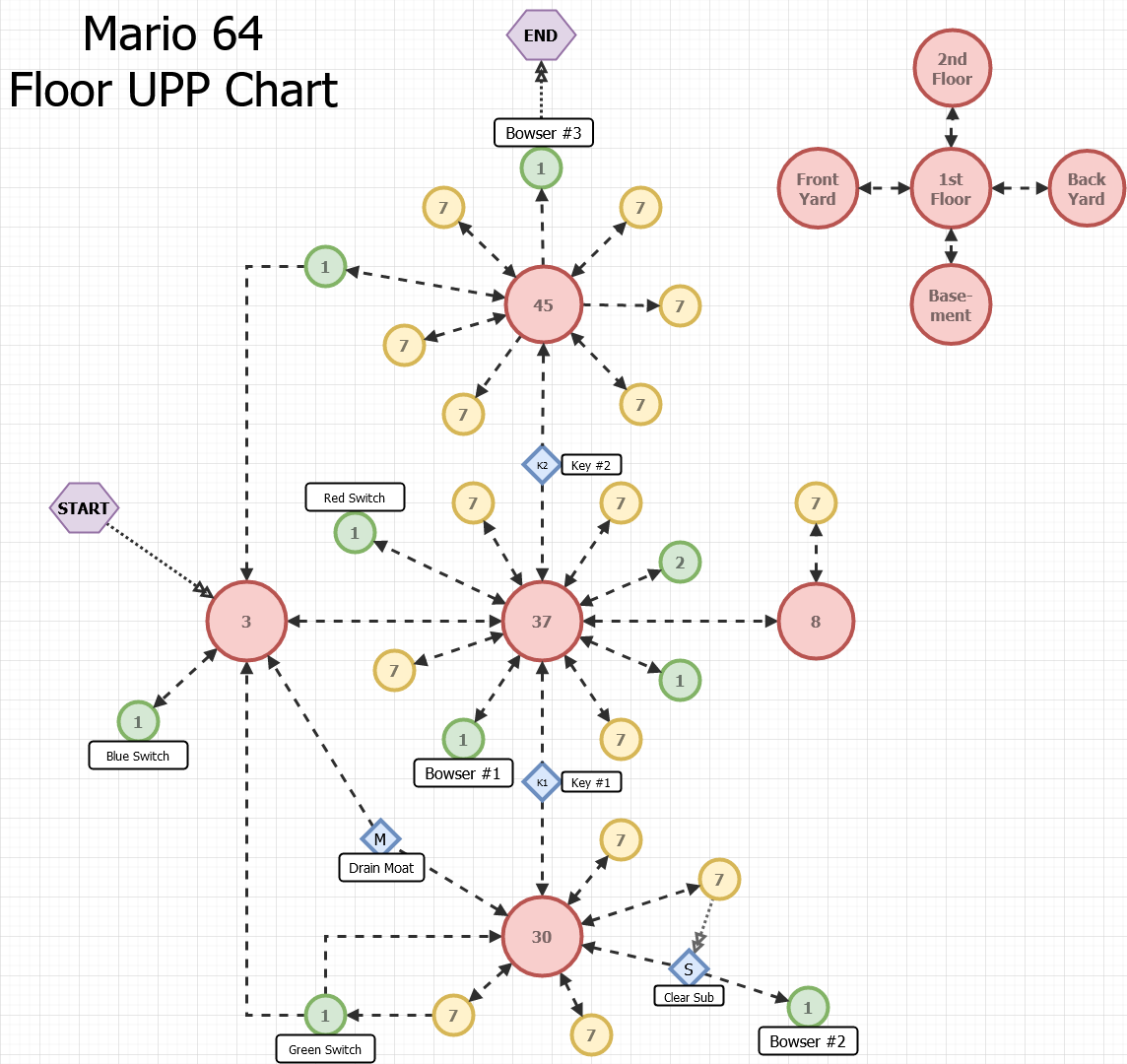Mario64 UPP Study
This note contains an analysis of the UPP (use-per-play) scores for the game Mario 64. UPP is a concept by Krystian Majewski in this blog article: Sword of Mana: World Design
In short, UPP is the minimum number of times a player must visit a given area in a game, per play - with "play" here defined as one whole playthrough of the game.
A UPP score can also be aplied to any game mechanic or asset. For example, you could chart the number of times (UPP) the game requires you to use the Metal Mario power-up to determine if the asset/mechanic is well-utilized, over-utilized, or under-utilized).
Making an evaluation on a mechanic's utilization itself is subjective, and depends on the goals and game flow of your particular game.
Example: Asset Recycling and UPP
A good asset UPP example:
-
Common assets like trees and rocks wil likely have a high UPP in a game, as they are reused frequently throughout a game. This makes the tree asset much more efficient, as the "milage" you get out of the labor put into designing it is stretched far.
-
On the other hand, if you reuse the same 2 NPC assets repeatedly, the asset itself will have a high UPP, but this will create a negative impact on the player. Seeing crowds of identical NPCs gives the player an uncanny feeling, and makes the game feel cheap.
The value of a high or low UPP is subjective, and dependent on the context in which the asset/mechanic/level/character is being utilized.
Tools
I have used a tool called diagrams.net (AKA draw.io) to map out the flow-charts for UPP.
- You can run it entirely in browser here: Mario64 - diagrams.net
- There's also a saved local copy of this file here:
Resources
I'm going to use this map from a DeviantArt account called VGCartography - Hobbyist, General Artist | DeviantArt. There's actually a ton of cool maps here too.

EXTRA: Here's some other cool map resources:
- 4:1 Massive Scale Super Mario 64 Project Minecraft Map
- [OC] Big Boo's Haunt : PixelArt
- Super Mario 64 Extra: Mushroom Kingdom Castle Map Map for Nintendo 64 by StarFighters76 - GameFAQs
UPP Level Analysis
If we consider all of Peach's Castle as "one area" (the Hub World) and each level itself as "one area", then the General UPP flow for Mario 64 looks like this:

The UPP can be measured to different levels of granularity. For example, if we instead consider each floor of the castle as its own area, and map out how they are connected to each level (and gated behind keys, etc) we get a UPP chart that looks more like this:

The arrows here show the directional relationship between areas in the game. Most areas are 2-way, allowing free travel between them. There are a few exceptions.
For example, you can only reach the Metal Cap Cavern (Green Switch) area by going through the level Hazy Maze Cave - but you can't go back to Hazy Maze Cave from the Metal Cap Cavern. And further, Metal Cap Cavern exits out one end to the waterfall in the Front Yard of the castle, but you can't re-enter Metal Cap Cavern by climbing up the waterfall.
The basement and 2nd floor are gated behind locked doors. Beating Bowser #1 and #2 will unlock these areas. This creates a certain progression flow, locking away the harder levels for later. But within each floor, you are given relative freedom to tackle the levels in any order you see fit.
This essentially creates a 3-tiered hub for the whole game, which later games such as Grand Theft Auto III also adopted.
In Mario 64 the hub areas (Peach's Castle) get a lot of use (UPP) in the game, as these hubs are the primary bridge between levels (most levels are not connected to each other in any way).
Alternatively, its entirely possible to deisgn a similar game flow chart, but replacing these Hub Areas with a simple 3-tiered "Overworld Map Screen" or even simple text-based Level Select Menu screen. But the benefit of the Nintendo Team choosing to make the Level Hub itself into a 3D explorable space, is that these areas allow the player to practice the new 3D controls and physics in a safe and fun playground-like area. A very smart decision on Nintendo's part.